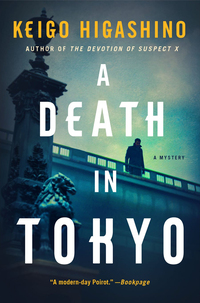
First published in Japan in 2011; published in translation by St. Martin’s/Minotaur Books on December 13, 2022
A police officer finds a man with a knife in his chest on the Nihonbashi Bridge, leaning against a parapet below two statues of kirin. The artist who created the statutes added wings to the mythical beasts. The man is rushed to a hospital where he dies without identifying his attacker.
The stabbing victim is Takeaki Aoyagi, an employee of Kaneseki Metals. As the police search a nearby park for suspicious persons, Fuyuki Yashima flees from an approaching officer. He is hit by a truck while running across the street. Yashima has Aoyagi’s wallet, making him the leading suspect in Aoyagi’s murder. Although Yashima’s wife isn’t particularly forthcoming with the police, the reader knows that he called her shortly before he died and said that he had done something awful.
American cops would have congratulated themselves for solving the case without exerting themselves. The Tokyo police are tempted to close the case with a finding that the killer is deceased. Fans of Keigo Higashino’s stories about police detective Kyoichiro Kaga will know that Kaga is never satisfied with circumstantial evidence. He wants everything to make sense and he’s not willing to close the case without discovering a sensible motive for the murder. He would also like to find a witness who saw Aoyagi and Fuyuki together before the murder occurred. To that end, Kaga and Shuhei Matsumiya repeatedly walk through the neighborhood where the crime occurred. The search brings them to a shrine in the Nihonbashi Seven Lucky Gods shrine group and the discovery that someone regularly left one hundred origami cranes (all the same color, but each set a different color) at the shrines. Kaga eventually realizes that the cranes are a clue.
A motive appears when Kaga learns that Yashima had been employed at Kaneseki Metals as a temp worker. Aoyagi was a supervisor who may have participated in unethical conduct that harmed Yashima. But why did Yashima suddenly decide to take revenge on Aoyagi? Did they arrange to meet? If their encounter was a coincidence, why did Yashima have a knife? Kaga refuses to declare the crime solved until he has all the answers. And if Yashima isn’t the killer, who did the deed?
The intricate plot involves several additional characters, including members of Aoyagi’s family and Yashima’s girlfriend. Some of the characters learn lessons about accepting responsibility for bad deeds and having faith in the people we love. Higashino constructs the plot like an origami crane, folding the facts this way and that until they reveal something previously unseen. Higashino leaves no loose ends in this police procedural as each clue eventually contributes to the mystery’s resolution. Even the kirin statues have significance.
In that sense, this is a classic detective story, the kind of thing that Agatha Christie and Rex Stout used to write. Mysteries have grown out of fashion in the US, having been supplanted by plots that feature tough guys who give more attention to guns than clues, but pure detective fiction remains popular in Japan. Hagashino is one of the genre’s contemporary masters.
Higashino’s descriptions of shrines, stores, restaurants, and the Nihonbashi Bridge give the story a strong sense of atmosphere. While he was writing for a Japanese audience, his explanations of Japanese traditions open a window into Japanese culture for foreign readers. Higashino devotes a subplot to a Japanese tradition of honoring the dead. Kaga did nothing on the first anniversary of his father’s death and must deal with family pressure to organize a memorial service for the second anniversary. Kaga doesn’t see the point of memorial services, but the brief skirmishes with family members give Higashino a chance to flesh out Kaga’s personality (or lack of personality when he isn’t doggedly solving crimes). Higashino gives more attention to characterization in his Detective Galileo series, but his Detective Kaga books are equally a must for mystery fans.
RECOMMENDED